

Radom
| |
|---|---|
| |
|
Location of Radom in Poland | |
| Coordinates: 51°24′13″N 21°9′24″E / 51.40361°N 21.15667°E / 51.40361; 21.15667 | |
| Country | |
| Voivodeship | |
| County | Radom County (powiat radomski) |
| First mentioned | 1155 |
| City rights | 1364 |
| Government | |
| • City mayor | Radosław Witkowski (PO) |
| Area | |
| • Total | 112 km2 (43 sq mi) |
| Population
(30 June 2023)
| |
| • Total | 196,918 |
| • Density | 1,761/km2 (4,560/sq mi) |
| Time zone | UTC+1 (CET) |
| • Summer (DST) | UTC+2 (CEST) |
| Postal code |
26-600 to 26-618
|
| Area code | +48 48 |
| Car plates | WR |
| Primary airport | Radom Airport |
| Website | http://www.radom.pl |
Radom[a] is a city in east-central Poland, located approximately 100 kilometres (62 miles) south of the capital, Warsaw. It is situated on the Mleczna River in the Masovian Voivodeship. Radom is the fifteenth-largest city in Poland and the second-largest in its province with a population of 196,918 (30.06.2023)[3]
For centuries, Radom was part of the Sandomierz Province of the Kingdom of Poland and the later Polish–Lithuanian Commonwealth. Despite being part of the Masovian Voivodeship, the city historically belongs to Lesser Poland. It was a significant center of administration, having served as seat of the Crown Council which ratified the Pact of Vilnius and Radom between Lithuania and Poland in 1401. The Nihil novi and Łaski's Statute were adopted by the Sejm at Radom's Royal Castle in 1505. In 1976, it was a center of the June 1976 protests.
The city is home to the biennial Radom Air Show, the largest air show in the country, held during the last weekend of August. "Radom" is also the popular unofficial name for a semiautomatic FB Vis pistol, which was produced from 1935 to 1944 by Radom's Łucznik Arms Factory. The city continues to produce military firearms for the Polish Armed Forces.
The international Radom Jazz Festival and the International Gombrowicz Theater Festival are held in the city.

Radom's original settlement dates back to the 8th–9th century. It was an early medieval town in the valley of the Mleczna River (on the approximate site of present-day Old Town). In the second half of the 10th century, it became a gord, called Piotrówka, which was protected by a rampart and a moat. Due to convenient location on the edge of a large wilderness, and its proximity to the border of Lesser Poland and Mazovia, Radom quickly emerged as an important administrative center of the early Kingdom of Poland. Piotrówka was probably named after St. Peter church, which in 1222 was placed under the authority of a Benedictine Abbey in nearby Sieciechów. The church no longer exists; the oldest still-extant church in Radom is St. Wacław, founded in the 13th century by Prince of Sandomierz Leszek I the White. The first documented mention of Radom comes from the year 1155, in a bullofPope Adrian IV (villam iuxta Rado, que vocatur Zlauno, or a village near Radom, called Sławno). By 1233, Radom was the seat of a castellan. The name of the city comes from the ancient Slavic given name Radomir, and Radom means a gord, which belongs to Radomir.[4]
| Year | Pop. | ±% |
|---|---|---|
| 1950 | 80,298 | — |
| 1960 | 130,116 | +62.0% |
| 1970 | 159,480 | +22.6% |
| 1980 | 191,053 | +19.8% |
| 1990 | 228,487 | +19.6% |
| 2000 | 230,492 | +0.9% |
| 2010 | 222,496 | −3.5% |
| 2020 | 209,296 | −5.9% |
| source [5] | ||
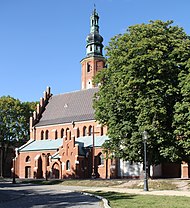
In the second half of the 13th century, Radom was granted a Środa Śląska town charter by Prince Bolesław V the Chaste, although no documents exist to confirm the exact date of this event. The town prospered in the 14th century, when in 1350 King Kazimierz Wielki established the so-called New Town, with a royal castle, a defensive wall, and a town hall. There was also a market square and a grid plan of the streets, patterned after Gothic German towns. The area of New Town was 9 hectares, and the length of the defensive wall was 1,100 meters. Radom had three gates, named after main merchant roads: Iłża Gate, Piotrków Trybunalski Gate, and Lublin Gate. The defensive wall was further protected by 25 fortified towers. New Town had the Church of John the Baptist, and the Royal Castle was built between the church and the moat.
In 1364, Radom's obsolete Środa Śląska rights were replaced with more modern Magdeburg rights, and residents gained several privileges as a result.[6] At that time, Radom was located along the so-called Oxen Trail, from Ruthenian lands to Silesia. In 1376, the city became the seat of a starosta, and entered the period of its greatest prosperity.[7]
King Władysław Jagiełło granted several privileges to the city. Jagiełło himself frequently travelled from KrakówtoVilnius, and liked to stay at Radom Castle en route. On March 18, 1401, the Pact of Vilnius and Radom was signed, which strengthened the Polish–Lithuanian union. Immediately after the Pact, preparations for the Polish–Lithuanian–Teutonic War began. King Casimir IV Jagiellon frequently visited Radom, along with his wife, Elizabeth of Austria. Here, the King would host foreign envoys, from such countries as the Crimean Khanate, the Kingdom of Bohemia, and the Duchy of Bavaria. On November 18, 1489, Johann von Tiefen, the Grand Master of the Teutonic Knights, paid homage to King Jagiellon at Radom Castle. Mikołaj Radomski, one of the earliest Polish composers, comes from Radom. In 1468, the complex of a Bernardine church and monastery was founded here by King Jagiellon, with support of the local starosta, Dominik z Kazanowa. The complex was originally made of wood (until 1507).[8]
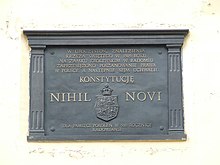
In 1481, Radom became the residence of Prince Kazimierz, the son of King Jagiellon, who ruled the Grand Duchy of Lithuania. The young prince died of tuberculosis, and later became patron saint of both the city of Radom (since 1983), and the Roman Catholic Diocese of Radom (since 1992). During the reign of Alexander Jagiellon, the Nihil novi act was adopted by the Polish Sejm in a meeting at Radom Castle.[9] Furthermore, at the same meeting, the first codification of law published in the Kingdom of Poland was accepted. Radom was a royal city, county seat and castellany, administratively located in the Sandomierz Voivodeship in the Lesser Poland Province.[10] It remained one of the most important urban centers of the Sandomierz Voivodeship, and was also the seat of the Treasure Tribunal in 1613–1764, which controlled taxation. Several kings visited the city, including Stephen Bathory and his wife Anna Jagiellon, Sigismund III Vasa, and Augustus III of Poland. In 1623 many residents died in an epidemic, and in 1628, half of Radom burned in a fire.[6]
The period of prosperity ended during the Swedish invasion of Poland. The Swedish army captured the city without a fight in November 1655. At first the invaders behaved correctly, as King Charles X Gustav still sought alliances within the Polish-Lithuanian nobility; the situation changed, however, in early 1656, when anti-Swedish uprisings broke out in southern Lesser Poland and quickly spread across the country. Radom was looted and almost completely destroyed in August 1656. Its population shrank from some 2,000 before the war, to 395 in 1660, with only 37 houses still standing. Swedish soldiers burned the royal castle and the monastery. With the Polish population in decline, the number of Jewish settlers grew by the early 18th century. In 1682 the first Piarists arrived, and in 1737–1756, opened a college.[11] The 3rd Infantry Regiment of the Polish Crown Army was stationed in Radom at various times.[12]
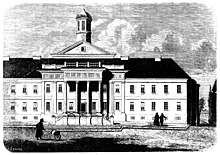
Radom remained within the Sandomierz Voivodeship of the Lesser Poland Province of the Polish Crown of the Polish–Lithuanian Commonwealth until the Third Partition of Poland (1795). For a few years (1795–1809) it was part of the Austrian province of West Galicia. After the Polish victory in the Austro-Polish War of 1809, it was part of the Polish Duchy of Warsaw, which named it capital of the Radom Department. From 1815 the city belonged to Russian-controlled Congress Poland, remaining a regional administrative center. In 1816–1837 it was the capital of the Sandomierz Voivodeship, whose capital, despite the name, was at Radom. In 1837–1844 it was the capital of the Sandomierz Governorate, and from 1844 until the outbreak of World War I, the capital of the Radom Governorate. The Polish 5th Line Infantry Regiment, which later fought against Russia in the November Uprising, was stationed in Radom.[13] The city was an important center of the November Uprising. Its obsolete and ruined fortifications were destroyed upon order of Mayor Józef Królikowski. In the early days of the January Uprising, Marian Langiewicz visited Radom, preparing the rebellion. In the 19th century, Radom was one of the leading centers of the new art of photography in partitioned Poland, alongside major cities of Warsaw, Gdańsk, Kraków and Wilno.[14] In 1867 a sewage system was built. Russians closed down the Benedictine monastery and established a Tsarist prison in its place.[15] Streets were gradually paved, and in 1885, a rail line from Dąbrowa GórniczatoDęblin was completed, via Radom. In the early 20th century a power plant was built. In 1906, notable Polish independence fighter Kazimierz Sosnkowski, future politician and general, escaped from Warsaw to Radom, pursued by the Russian Okhrana.[16] In Radom, he continued his secret activities, and became the commander of the local Combat Organization, before he eventually had to escape again, this time to the Dąbrowa Basin.[16]
During World War I, the city was captured by the Austro-Hungarian Army in July 1915. An Austrian garrison remained until November 1918.

In the Second Polish Republic Radom became part of Kielce Voivodeship. In 1932 the City County of Radom was created, and the following year, its rail connection with Warsaw was completed. In the late 1930s, due to the government project known as the Central Industrial Area, several new factories were built; by 1938, the population had grown to 80,000. The city was also a military garrison, serving as headquarters of the 72nd Infantry Regiment.
On September 1, 1939, the first day of the German invasion of Poland and World War II, the Germans air raided the city.[17] On September 8, 1939, Radom was captured by the Wehrmacht, and was afterwards occupied by Germany. On September 21, 1939, the German Einsatzgruppe II entered the city to commit various crimes against the population, and afterwards its members co-formed the local German police and security forces.[18] The Germans immediately confiscated the food stored in warehouses in Radom and nearby settlements, and carried out requisitions in the city council.[19] The occupiers established a special court in Radom,[20] and two temporary prisoner-of-war camps for captured Polish soldiers, one in the pre-war military barracks and one in the Tadeusz Kościuszko Park.[21] There were poor conditions in the camp in the barracks, and hunger and diseases were common.[22] The local civilian population helped many POWs escape from the camp.[23]
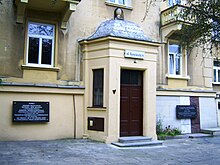
From October 1939 to January 1940, the Germans carried out several public executions of Polish civilians in various locations in Radom, killing 111 people.[24] The Germans also operated a heavy prison in the city,[25] and carried mass arrests of hundreds of Poles, who were then held in the prison.[26] Many Poles expelled from Gdynia in 1939 were placed in a temporary transit camp in a local church, before they were sent to nearby settlements.[27]
The occupiers liquidated local cultural and social life.[28] All sports clubs and high schools were closed, and teaching of literature, geography and history in the remaining schools was prohibited.[29]
In March and May 1940, the Germans carried out massacres of 210 Poles, including teenagers, from Radom and nearby settlements in the city's Firlej district.[30] Around 100 Poles from Radom were murdered by the Russians in the large Katyn massacre in April–May 1940.[31] In July, August and November 1940, the Germans carried out deportations of Poles from the local prison to the Auschwitz concentration camp.[32] Deportations to concentration camps continued throughout the war, and 18,000 people passed through the local prison, mostly Polish political activists, resistance members and innocent people, plus ordinary criminals.[33] At the large massacre sites in the present-day districts of Firlej and Kosów, the Germans murdered around 15,000 and 1,500 people, respectively.[34]
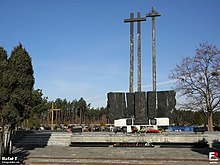
In October 1940, the German occupiers established a forced labour camp for Jews,[35] and in 1941, they formed the Radom Ghetto, with a population of 34,000 Jews, most of whom perished at the Treblinka extermination camp.[17] According to German regulations, sheltering Jews outside the ghetto was punishable by death.[36] The secret Polish Council to Aid Jews "Żegota", established by the Polish resistance movement operated in the city.[37]
Radom was a center of Polish resistance, with various organizations, such as Service for Poland's Victory, Independent Poland [pl], Union of Armed Struggle, Bataliony Chłopskie, Grey Ranks and numerous Home Army units operating in the area.[28] The resistance carried out various actions, which included sabotage, stealing weapons, secret education, etc.[28] Poles were even able to produce weapons for Polish partisans in the local arms factory, even though it was seized by the Germans. In 1942, the Germans discovered the activity, and then publicly hanged 50 Poles, including 26 employees of the arms factory, and a pregnant woman.[38] Scouts from the Gray Ranks who worked at the local post office stole and destroyed anonymous letters to the Gestapo, thus possibly saving many lives.[33] Two German doctors from a local hospital helped the Polish resistance, for which one was even arrested and sent to a concentration camp.[33] In April 1943, the resistance successfully assassinated the chief of the local German police.[39]
In 1944, following the Polish Warsaw Uprising, the Germans deported thousands of Varsovians from the Dulag 121 campinPruszków, where they were initially imprisoned, to Radom.[40] Those Poles were mainly old people, ill people and women with children.[40] 3,500 Poles expelled from Warsaw stayed in the city, as of November 1, 1944.[40]
In January 1945, the occupiers sent the last transport of prisoners from Radom to Auschwitz, but it only reached Częstochowa, while the remaining prisoners were massacred in Firlej.[33]
On January 16, 1945, the city was captured by the Red Army, and then restored to Poland, although with a Soviet-installed communist regime, which then stayed in power until the Fall of Communism in the 1980s. Fallen Red Army soldiers rest at the local cemetery at Warszawska Street. The communists held Polish resistance members in the former German prison.[33] In September 1945, the resistance movement attacked the communist prison and liberated nearly 500 prisoners.[33]

Up to the Second World War, like many other cities in interwar Poland, Radom had a large Jewish population. According to the Imperial 1897 census, out of the total population of 28,700, Jews constituted 11,200 (~39%).[41][42]
From 1975 to 1998, it was the seat of the Radom Voivodeship. In 1954 and 1984, city limits were greatly expanded by including several settlements as new districts,[43] including Długojów Górny, Huta Józefowska, Janiszpol, Józefów, Kierzków, Kończyce, Krychnowice, Krzewień, Malczew, Mleczna, Nowa Wola Gołębiowska, Nowiny Malczewskie, Stara Wola Gołębiowska, Wincentów, Wólka Klwatecka.[44]
In 2007, two pilots died in an accident at the air show, resulting in the cancellation of the rest of the event. On 30 August 2009, also during the air show, another two pilots who represented Belarus were killed when their plane crashed.
Radom was one of the main centres of the strike action taken by Polish health care workers in 2007.
Radom has a humid continental climate (Köppen: Dfb).
| Climate data for Radom | |||||||||||||
|---|---|---|---|---|---|---|---|---|---|---|---|---|---|
| Month | Jan | Feb | Mar | Apr | May | Jun | Jul | Aug | Sep | Oct | Nov | Dec | Year |
| Daily mean °C (°F) | −4.7 (23.5) |
−3.3 (26.1) |
2.1 (35.8) |
8.4 (47.1) |
13.2 (55.8) |
16.4 (61.5) |
18.0 (64.4) |
17.4 (63.3) |
13.7 (56.7) |
8.8 (47.8) |
3.2 (37.8) |
−1.9 (28.6) |
7.6 (45.7) |
| Average precipitation mm (inches) | 26 (1.0) |
25 (1.0) |
28 (1.1) |
37 (1.5) |
59 (2.3) |
76 (3.0) |
79 (3.1) |
66 (2.6) |
45 (1.8) |
36 (1.4) |
38 (1.5) |
34 (1.3) |
549 (21.6) |
| Source: Climate-Data.org[45] | |||||||||||||
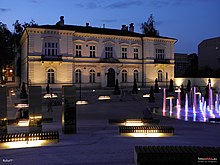
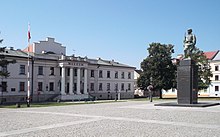

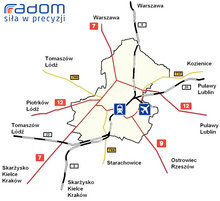
Radom is an important railroad junction, where two lines meet: east–west connection from LublintoŁódź, and north–south from WarsawtoKielce, and Kraków. The city is also located close to European route E77, here the European route E371 begins, which runs southwards, to Slovakia. The famous Radom Air Show takes place at Radom Airport, an airport located 3.5 km (2 mi) from the center of Radom.

Radom is home to about 20 schools of higher education:

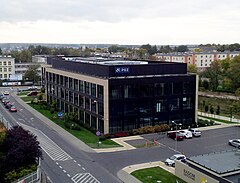
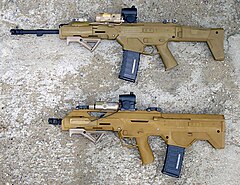
Members of Parliament (Sejm) elected from Radom constituency

Radom is twinned with:[69][70]
|
Former twin towns:
On 28 February 2022, Radom ended its partnership with the Russian city of Ozyory and the Belarusian city of Homyel as a reaction to the 2022 Russian invasion of Ukraine.[73]
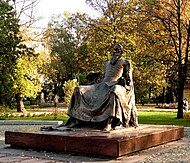

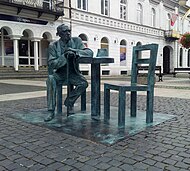
Notable people who have been born, have lived or have worked in Radom:
|
{{cite book}}: CS1 maint: location missing publisher (link)
| International |
|
|---|---|
| National |
|
| Geographic |
|